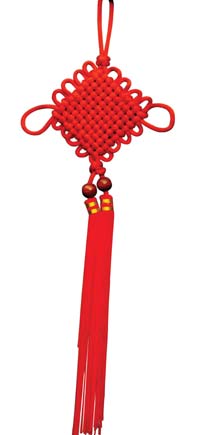| Paint the Town Red |
| http://www.sina.com.cn 2005/03/31 19:48 thats China |
Red envelopes (hong bao)
On New Year's Day itself, the ancient custom of giving hong bao takes place. Older relatives give younger members paper money in small red envelopes; usually an even amount of money is given as odd numbers are seen as unlucky. Because the older Chinese believe that everyone grows one year older on New Year's Day, the cash is also called ya sui qian (age-suppressing money) which is said to keep children young. Paper cuts (jian zhi)
Making jian zhi is an ancient Chinese folk art that dates back to the Southern and Northern Dynasties (420-589). Traditionally, professional craftsmen made paper cuts by hand; today, most paper cuts are made by machine. Red paper cuts are a sign of good fortune and are pasted on house and restaurant windows. The bat is a popular cutting, as the Chinese word for bat is fu, which sounds like the character for good fortune. Fish are also a common paper cut, as the Chinese word yu sounds like the term for plenty. Chinese knots (zhong guo jie) The ancient folk art of knotting was developed in the Tang and Song dynasties (618-1279). Each knotted shape has a special meaning: The most common is the red, diamond-shaped knot, which means "forever happy." Other knots include "prosperity" knots (decorated with chili peppers); "romance" (in heart-shaped patterns); "fortune" (tied with ancient coins); "happiness" (featuring the double-happiness character); and "longevity" (100 coins bound with red thread). It's popular for women to wear a small version of the knots as a necklace. Dragon dance (wu long)
The dragon dance is usually performed once during the Spring Festival, most likely during the Lantern Festival (the last day of the festivities). The Chinese consider dragons to be friendly, helpful creatures and associate them with strength, good fortune, wisdom and longevity. The longer the dragon, the more luck it brings: Some dragons require thirty people to hold up the tail. Drums, gongs and cymbals set a loud, fast rhythm for the dance. Spectators may offer money, which the performers try to grab by standing on each other's shoulders. Lion dance (wu shi) The lion dance is performed early in the Spring Festival. There are two types of lions: Northern lions have muzzles like dogs, while Southern lions are decorated with horns and two long whiskers. The dance is traditionally performed by two gong fu students, one sitting on top of the other's shoulders.
|
|
|
|
|
|
| Annotation |
| 新 闻 查 询 |
| 热 点 专 题 | ||||
| ||||
|
教育频道意见反馈留言板 电话:010-82628888-5747 欢迎批评指正
新浪简介 | About Sina | 广告服务 | 联系我们 | 招聘信息 | 网站律师 | SINA English | 会员注册 | 产品答疑
Copyright © 1996 - 2005 SINA Inc. All Rights Reserved
版权所有 新浪网![]() 北京市通信公司提供网络带宽
北京市通信公司提供网络带宽


